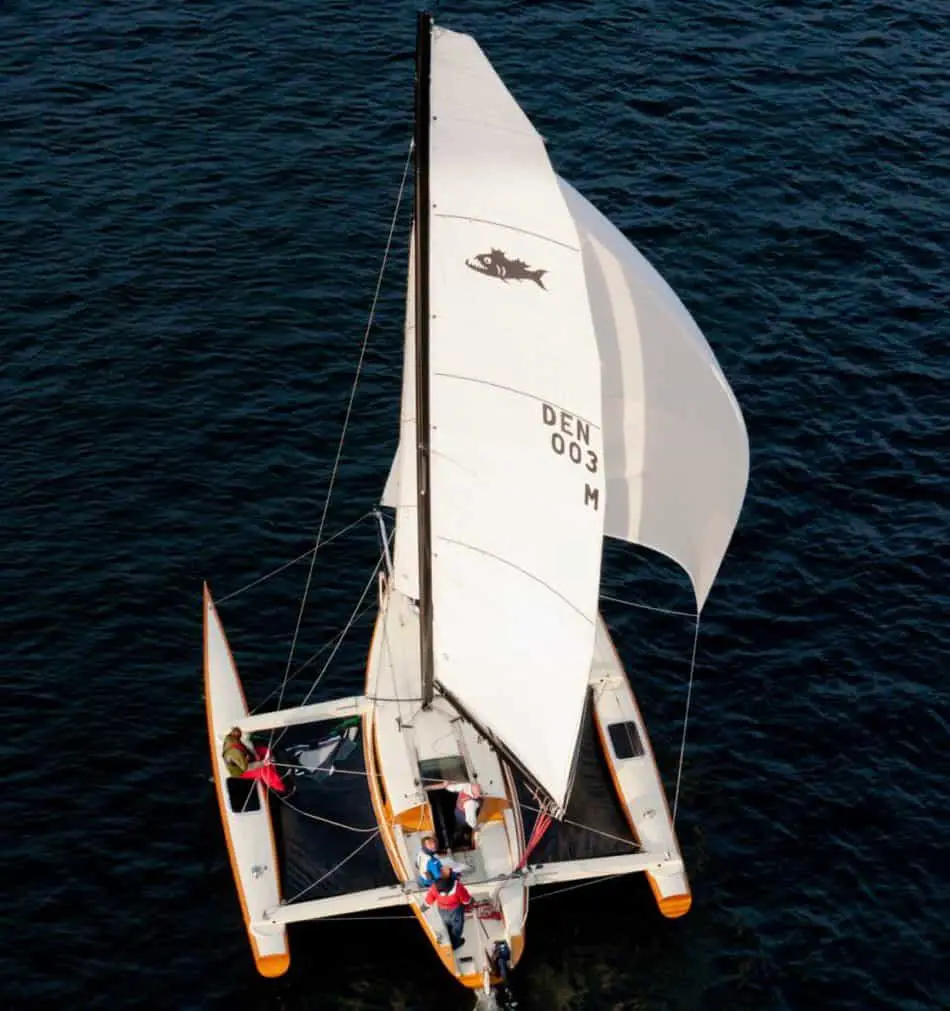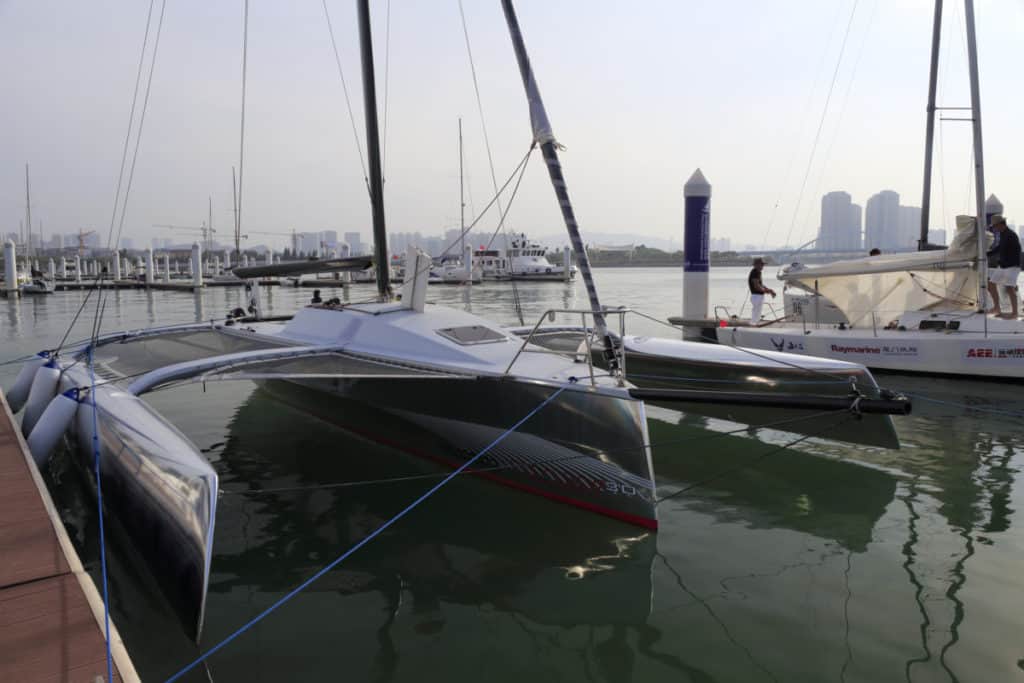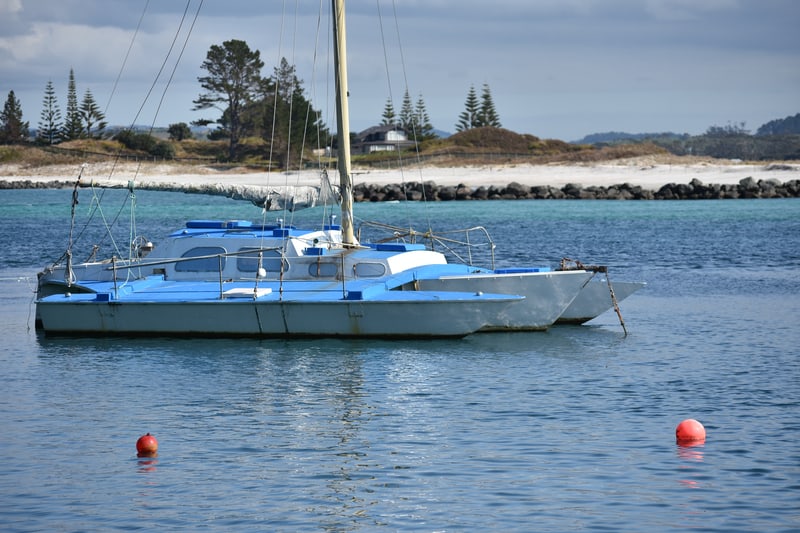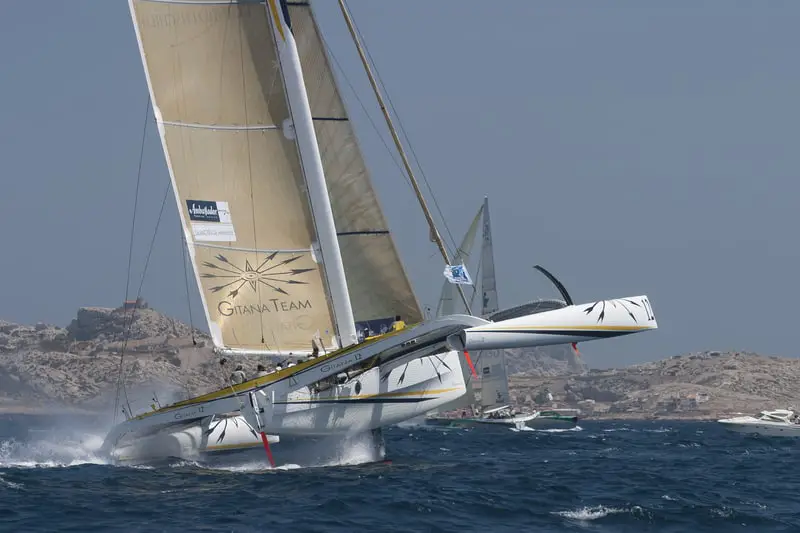As an Amazon Associate, we earn from qualifying purchases. We may also earn commissions if you purchase products from other retailers after clicking on a link from our site.
Trimarans are known for their speed and excellent performance. However, not every vessel performs well in the ocean’s rolling waves, which begs the question – are trimarans able to handle rough seas?
Trimarans are seaworthy because their tri-hull construction makes them incredibly stable, even in the roughest sea conditions. They are lightweight, very buoyant, easy to handle, fast, and resistant to capsizing. Trimarans also have a shallow draft.
So, let’s get into the details and discuss why trimarans are an excellent choice for seafaring. I’ll tell you more about the features that make them safe and ideal for traversing the oceans. So, let’s get into it.
What Makes A Trimaran Seaworthy?

A trimaran is seaworthy because of its wide base giving it capsize resistance, its high speeds allowing for outrunning storms, and good maneuverability, making transiting stormy areas with precision, safer.
I’ll describe these factors in more detail below:
Buoyant Construction
One of the most important factors making trimarans seaworthy is their buoyant construction.
Modern trimarans are made from two lightweight fiberglass layers with a foam core, giving them exceptional buoyancy.
This should be seen in comparison to their lead keel counterpart, the monohull.
Trimarans also consist of various sealed parts, allowing them to remain afloat if one or more parts become damaged in a collision. If the worst came to the worst and the ocean obliterated the entire trimaran, there would still be buoyant pieces to act as rafts for the crewmembers to hold onto.
Many trimarans also have watertight crossbeams between the hulls, further increasing their buoyancy.
If the trimaran were to become filled with water, any of its hulls would be able to keep it afloat.
Stability

Catamarans are known for their excellent stability, and if they heel (lean over with wind-filled sails), they can right themselves up to a 12° angle before flipping over.
To understand when a catamaran or trimaran will capsize, I suggest you read this article: Why Catamarans Capsize.
On the other hand, Trimarans are well-known for their righting torque (the ability of a vessel to right itself before flipping over). These vessels can reach a 27° angle before they flip over, but the trimaran will likely remain floating even if this happens.
So, although they heel more than cats, and studies suggest they would capsize “more easily”, they are very stable.
This stability and ability of trimarans to keep themselves upright are due to their wise base. Just like when someone pushes you, you take a step to widen your base, so do the trimarans amas (the floats to either of the side of the center hull).
This means that the wind’s force can push harder on the sails before it flips, harder than if it had a narrow base (monohull or cat).
With its tri-hull design, a trimaran’s weight is distributed primarily on the middle hull. This mid-central balance provides a lot of vertical stability for the vessel, but the two outrigger hulls (a.k.a. amas, connected via lateral beams) give added sideway stability. Its multi-directional strength allows a trimaran to remain stable even in the roughest seas.
While monohulls are heavy and tend to go through the waves, trimarans are light and go over. This means higher speeds but also a different more bumpy ride, at least while going into the wind.
A trimaran’s three hulls will contact the wave at different points. However, because their hulls are slimmer than a monohulls, they can slice through waves more easily but will lack the kinetic energy to drive through.
Shallow Draft

A boat’s draft refers to the distance between the bottom of the boat and the waterline. Trimarans have a very shallow draft due to their lightweight construction, hull design, and buoyancy.
A trimaran’s shallow draft means that it will be able to sail in waters that monohulls can’t. This allows for more shallow water harboring options, something that can be very useful when a storm is approaching.
Maneuverability
Lightweight and responsive steering means not only that a trimaran is fun to sail, but it also allows for more precise maneuvering. This is not only useful in marinas when navigating tight quarters, but it is also essential when transiting large waves at the right angle.
Capsizing Resistance
A trimaran’s design makes it very unlikely to capsize as it has a fast-draining deck, open-weave wing nets, and a wide base.
The fast-draining deck and cockpit have drainage holes to help prevent waterlogging in extreme conditions.
Trimarans also have open-weave wing nets to help decrease windage and reduce the amas susceptibility to digging into the water when waves crash over it.
As noted above, the trimarans main feature, the wide stance, allows for more power to the sail before there is a need to reef. This means higher speeds!
Speed
Speed is not a primary factor contributing to seaworthiness, but speed can improve a boat’s safety in storms.
If the trimaran encounters a dangerous storm, its high-speed capability allows it to move out of the stormy area faster, decreasing the chances of an accident.
Safe Cockpit
Trimarans usually have sealed or partially sealed cockpits with windshields, allowing the captain and crew members to navigate the vessel comfortably, even in extreme weather conditions.
A trimaran’s protected cockpit also helps keep the vessel’s essential navigational equipment safe during stormy conditions, contributing to its seaworthiness.
Final Thoughts
So Are Trimarans Safe In Rough Seas?
Are you in the market for a new boat and considering a trimaran? If so, you may wonder how safe they are on rough seas.
Trimarans are safe in rough seas because they have high righting torques, and conditions have to be extreme before they flip over. They have excellent vertical and lateral stability due to their tri-hull design, and their buoyant construction helps keep them afloat.
Trimarans are some of the speediest vessels out there, and in rough seas, they can move out of the stormy area and into safety. They are also easy to handle and have protected cockpits, making them safer to use on rough seas.
Trimarans are seaworthy because they have three hulls, giving the vessel excellent stability, even in extremely rough seas. They consist of lightweight and buoyant foam-core material with multiple sealed sections to allow them to float if one or more parts become damaged.
Trimarans can quickly move to shallow harbors in storms with their shallow drafts and high-speed ability.
Trimarans are easy to handle, and their sheltered cockpits make it easy for the crew to navigate them expertly through the sea. The cockpit or deck is unlikely to become waterlogged because of the drainage.
Sources
- Shuttleworth Design: Multihull Design Considerations for Seaworthiness
- Yachting & Boating World Forum: Are trimarans safe?
- Chemical & Engineering News: What’s fiberglass, and how does the delicate material reinforce thousands of products?
- The Free Dictionary: Heeling
- Wordnik: Outrigger
- Discover Boating: What is Boat Draft?

